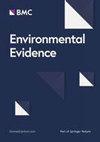To what extent does surrounding landscape explain stand-level occurrence of conservation-relevant species in fragmented boreal and hemi-boreal forest? – a systematic review
IF 5.2
4区 环境科学与生态学
Q2 ENVIRONMENTAL SCIENCES
引用次数: 0
Abstract
Forestry and land-use change are leading causes of habitat loss, degradation, and fragmentation worldwide. The boreal forest biome is no exception, and only a small proportion of this forest type remains intact. Since forestry will remain a major land-use in this region, measures must be taken to ensure forest dependent biodiversity. Stand level features and structures promoting conservation relevant species have received much attention, but the landscape level perspective is often missing. Hence, we review the literature that has related fragmentation in the surrounding landscape to occurrence of threatened, declining, red-listed, rare, or deadwood dependent species as well as those considered to be indicator, flagship, umbrella, and/or keystone species in a given boreal forest stand. A comprehensive search string was developed, benchmarked, and adapted for four bibliographic databases, two search engines, and 37 specialist websites. The online evidence synthesis tool Cadima was used for screening of both abstracts and full texts. All articles meeting the inclusion criteria were subject to study validity assessment and included in a narrative table. Studies reporting means and variance were included in quantitative meta-analysis when more than 3 comparable studies were available. The searches resulted in 20 890 unique articles that were reduced to 172 studies from 153 articles. These studies related stand level presence, abundance, species richness, and/or composition of conservation relevant species to landscape factors such as: categorical fragmentation intensity (higher vs. lower), amount of habitat or non-habitat, distance to habitat, and/or habitat configuration, on scales ranging from tens to tens of thousands of ha. Forty-three studies were suitable for meta-analysis. These showed a significant negative effect of fragmentation on both presence and abundance of conservation relevant species, as well as a near significant trend for species richness. This was particularly clear when fragmentation was measured as distance to surrounding habitat for presence, and as habitat amount for abundance. The organism groups with the strongest support for a negative effect of fragmentation were wood fungi and birds. As hypothesised, there is strong support for negative effects of fragmentation in boreal forest. These results emphasize the negative consequences of the intensive forestry and associated landscape transformation that has been the norm for the last century. We argue that this should have direct implications for policy makers to shift towards including a landscape perspective in all planning of harvesting, preserving, and restoring forest. In addition, we found that research effort has been very uneven between organism groups, that studies on landscape change over time were rare, and that many studies have not quantified the difference in fragmentation intensity among landscapes making it difficult to quantify the extent of the negative effect. One way forward would be to revisit the studies included here in to incorporate change over time, as well as a true quantification of landscape fragmentation. By doing so, the scale of the negative effects would be much better analysed, which would greatly assist conservation practitioners all throughout the boreal forest biome.周围景观在多大程度上解释了破碎的北方和半北方森林中与保护相关的物种在林分层面上的出现?- 系统综述
林业和土地使用的变化是导致全球栖息地丧失、退化和破碎化的主要原因。北方森林生物群落也不例外,这种森林类型中只有一小部分保持完好。由于林业仍将是该地区的主要土地利用方式,因此必须采取措施确保依赖森林的生物多样性。促进保护相关物种的林分级特征和结构已受到广泛关注,但景观级视角往往缺失。因此,我们回顾了相关文献,这些文献将周围景观的破碎化与特定北方林分中受威胁、衰退、列入红色名录、稀有或依赖枯木的物种以及被视为指示物种、旗舰物种、保护伞物种和/或基石物种的出现联系起来。我们为四个书目数据库、两个搜索引擎和 37 个专业网站开发了综合搜索字符串,并对其进行了基准测试和调整。在线证据综合工具 Cadima 用于筛选摘要和全文。所有符合纳入标准的文章均需进行研究有效性评估,并纳入叙述性表格中。如果有 3 项以上可比研究,则将报告均值和方差的研究纳入定量荟萃分析。通过检索,共获得 20 890 篇文章,并从 153 篇文章中筛选出 172 篇研究。这些研究将保护相关物种的林分水平存在、丰度、物种丰富度和/或组成与景观因素相关联,例如:分类破碎化强度(较高与较低)、栖息地或非栖息地数量、到栖息地的距离和/或栖息地配置,规模从几公顷到几万公顷不等。有 43 项研究适合进行荟萃分析。这些研究表明,破碎化对保护相关物种的存在和丰度都有明显的负面影响,对物种丰富度也有近乎明显的影响。如果以与周围栖息地的距离来衡量破碎化对物种存在的影响,以及以栖息地数量来衡量物种丰富度,这种影响尤为明显。对破碎化负面影响支持度最高的生物类群是木真菌和鸟类。正如假设的那样,在北方森林中,破碎化的负面影响得到了强有力的支持。这些结果强调了上个世纪的集约化林业和相关景观改造所带来的负面影响。我们认为,这将对政策制定者产生直接影响,促使他们在采伐、保护和恢复森林的所有规划中纳入景观视角。此外,我们还发现,不同生物群体之间的研究工作非常不均衡,有关景观随时间变化的研究也很少,而且许多研究都没有量化景观之间破碎化强度的差异,因此很难量化负面影响的程度。前进的方向之一是重新审视本文所包含的研究,将随时间推移而发生的变化以及景观破碎化的真正量化纳入其中。这样就能更好地分析负面影响的程度,从而为整个北方森林生物群落的保护工作者提供极大的帮助。
本文章由计算机程序翻译,如有差异,请以英文原文为准。
求助全文
约1分钟内获得全文
求助全文
来源期刊

Environmental Evidence
Environmental Science-Management, Monitoring, Policy and Law
CiteScore
6.10
自引率
18.20%
发文量
36
审稿时长
17 weeks
期刊介绍:
Environmental Evidence is the journal of the Collaboration for Environmental Evidence (CEE). The Journal facilitates rapid publication of evidence syntheses, in the form of Systematic Reviews and Maps conducted to CEE Guidelines and Standards. We focus on the effectiveness of environmental management interventions and the impact of human activities on the environment. Our scope covers all forms of environmental management and human impacts and therefore spans the natural and social sciences. Subjects include water security, agriculture, food security, forestry, fisheries, natural resource management, biodiversity conservation, climate change, ecosystem services, pollution, invasive species, environment and human wellbeing, sustainable energy use, soil management, environmental legislation, environmental education.
 求助内容:
求助内容: 应助结果提醒方式:
应助结果提醒方式:


